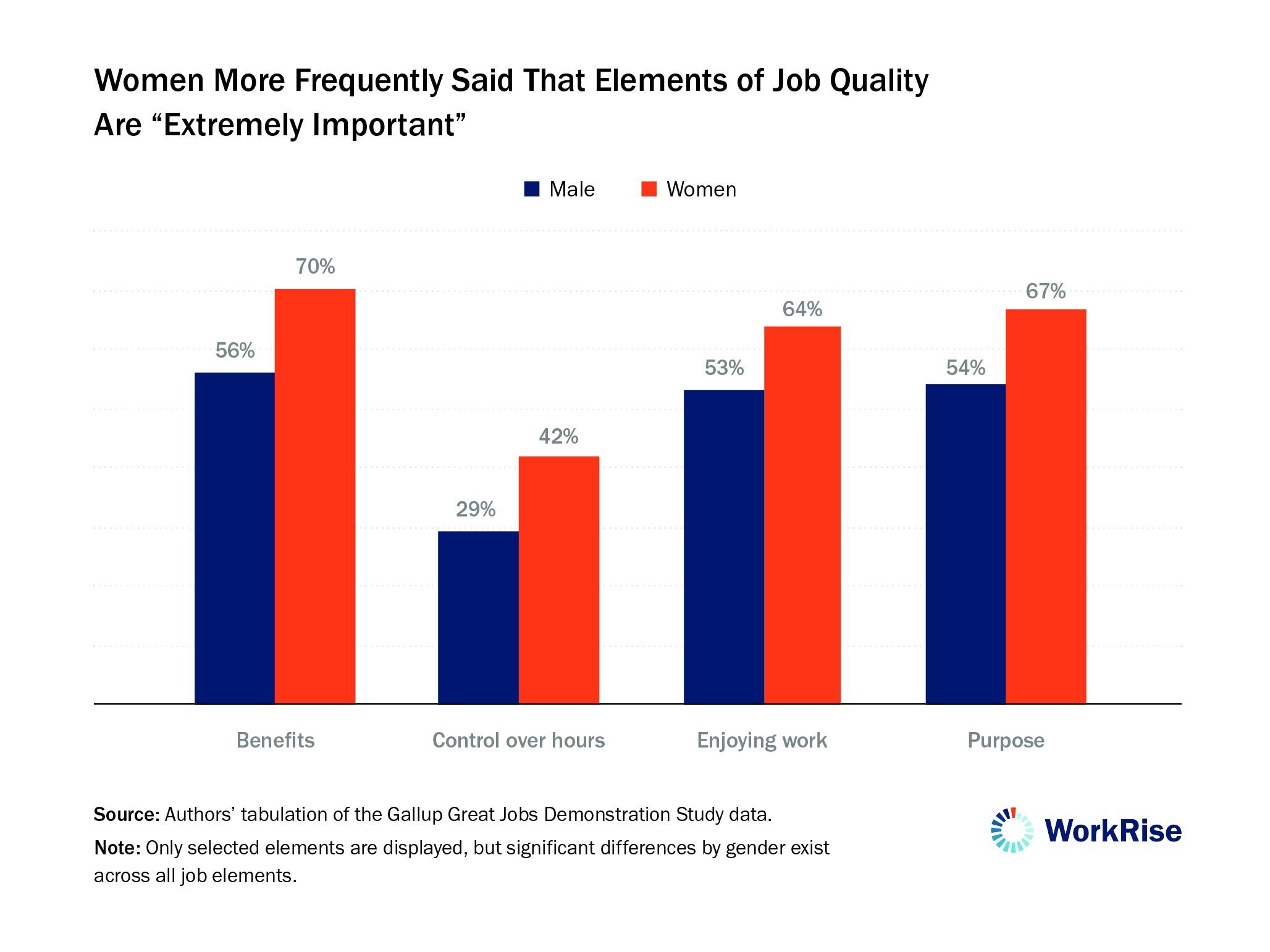This post is the fourth in a series devoted to exploring the elements of what makes a “good” or “quality” job and understanding the relationship between job quality and economic mobility, that is, the ability to advance and increase earnings in the labor market. These posts will elevate key insights from a new body of work from the Urban Institute that develops an agenda for research on how stakeholders, including policymakers, employers, advocates, and practitioners, can accelerate economic mobility among low-wage workers through elements of job quality. This post explores what workers say they value in jobs and what these preferences tell us; other posts explore a new framework for defining good jobs, evidence on job quality elements that facilitate economic mobility, taking a racial equity lens in improving access to good jobs, and a new agenda for research on job quality and mobility. To learn more about this project, visit Building America’s Workforce.
An important dimension to our work establishing a common framework for defining job quality and understanding how different job qualities influence economic mobility is giving voice to what workers themselves value in a job. We know workers will prefer one job over another if it fits better with their personal circumstances. Although there have been a few studies on differences in worker preferences by demographic characteristics, we sought to learn more. We turned to the 2019 Gallup Great Jobs Demonstration Survey of 9,671 participants to gain a better understanding of which job quality elements matter to workers and how differences in race and ethnicity, gender, age, and other factors shape those preferences. As we explore in greater detail in our research brief, the survey yielded the following insights on worker preferences.
Workers prefer “clusters” of job quality elements
The Gallup survey asks respondents to rate 10 job quality elements from 1 to 5, with 1 being “unimportant” and 5 being “extremely important” when determining if a job is good. Because most respondents rated all 10 elements at least “somewhat important,” we knew we had to dig deeper in the data to yield insights. As good jobs often contain multiple elements, we wondered how this would be reflected in data about workers’ preferences.
We ran correlations on each of the 10 elements to determine relationships between those workers ranked as “extremely important.” We found strong correlations between these five elements: level of pay, stability of pay, stability of hours, job security, and benefits. We also found strong correlations between four elements related to purpose and autonomy: control over hours, power to change things, enjoyment, and purpose. Interestingly, advancement was an element that had moderate but not strong correlation to other elements.
These insights suggest workers prefer jobs with clusters or bundles of elements, rather than any single element above others. To support broad efforts by advocates, employers, and other stakeholders to improve job quality, further research could delve into what job quality elements should be clustered to create a “good job.”
Women, Black, and Hispanic/Latinx workers are more likely to rank all job quality elements as “extremely important”
The Gallup survey also revealed that what workers value in a job varies considerably by gender, race and ethnicity, educational attainment, and other demographic factors. Across all 10 of the survey’s job quality measures, women, Black, and Latinx respondents consistently ranked each element as “extremely important” more often than men and white workers.
For example, 70 percent of women ranked benefits as “extremely important,” compared with 56 percent of men. Forty-two percent of women rated control over one’s hours as “extremely important,” compared with 29 percent of men. As demonstrated in the chart below, Black and Latinx/Hispanic respondents ranked level of pay and stable hours as “extremely important” at higher rates than white respondents. Differences in preference across race and ethnicity were largest for advancement, with 56 percent and 58 percent of Black and Latinx/Hispanic respondents, respectively, rating it as “extremely important,” compared with just 33 percent of white respondents.

Age also matters when it comes to workers’ preferences, with older workers rating benefits as “extremely important” more often than younger workers, who placed a higher value on enjoyment and advancement at work. Educational attainment also influenced people’s perceptions of job security and stability, with workers with less than a four-year college degree ranking level of pay and stable hours as “extremely important” more often than college grads.
So, what conclusions can we draw from data on worker preferences in the Gallup survey? The survey did not contain complete data on the jobs held by respondents at the time of the survey, so it is difficult to establish links between their preferences and qualities of their current jobs. We find it noteworthy that the respondents more likely to place high value on all 10 job quality elements are those more likely to work in low-quality jobs. Because of occupational segregation, women and workers of color are more likely to work in the service sector and other low-wage industries, in which jobs may not have the elements they seek and value. The survey responses suggest there may not be fundamental differences in what workers value in jobs, but that the quality of their current job shapes these preferences.
Future research on workers’ job quality preferences would benefit from having more granular data on the jobs survey respondents hold, beyond their demographic characteristics. Such research could help employers target and tailor their approaches to different workers to improve their engagement and satisfaction at work and could help worker advocates tailor advocacy campaigns around specific groups of workers who may be lacking specific job quality elements. These and other research gaps will be explored in our fifth and final post of this series.
We drew insights from the following for this post:
“What’s Important in a Job? An Analysis of What Matters and for Whom”
Not Just a Job: New Evidence on the Quality of Work in the United States